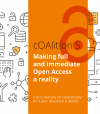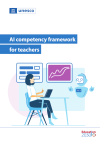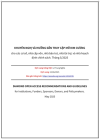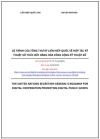Global Open Access Portal
United States of America
Nước Mỹ đã ôm lấy các nguyên tắc của Truy cập Mở - OA (Open Access) khi phát triển ERIC và MEDLINE vào năm 1960. Các sáng kiến như PubMed Central tiếp tục và chào các tiện ích kho và truy cập tới các tài nguyên hàn lâm y học. Cho tới tháng 5/2015, có 469 kho OA được đăng ký trên OpenDOAR và 1053 tạp chí OA từ Mỹ được đánh chỉ mục trong DOAJ, làm cho Mỹ trở thành nhà xuất bản OA lớn nhất thế giới.
Thư mục các Tài nguyên Hàn lâm Truy cập Mở - ROAD (Directory of Open Access Scholarly Resources) hiện liệt kê 1 Blog Hàn lâm từ Mỹ.
Cho tới tháng 2/2015, 127 chính sách OA được đăng ký trên ROARMAP.
Môi trường xúc tác:
Có sự hỗ trợ mạnh mẽ cho Truy cập Mở ở Mỹ. Chỉ thị của NIH bắt buộc ký gửi nghiên cứu y học. Tới tháng 5/2015, Mỹ có 5 chỉ thị cấp vốn được đăng ký trên ROARMAP và hơn 50 chỉ thị cấp cơ sở trong các cơ sở công và tư, các trường đại học nghiên cứu và các trường cao đẳng nghệ thuật tự do.
Vào tháng 2/2013, chính phủ Mỹ đã công bố chính sách OA mới của mình, đã bắt buộc tất cả các xuất bản phẩm phát sinh từ nghiên cứu từ tiền của người đóng thuế sẽ phải được làm để tự do đọc được sau một giai đoạn cấm vận 1 năm. Đây là sự mở rộng trong chính sách đã có cho tới khi đó chỉ áp dụng cho các khoa học y sinh.
Các rào cản tiềm tàng:
Các rào cản chính là sự hiểu sai rộng khắp về OA; sự vận động hành lang của việc xuất bản được cấp vốn tốt.
Các dự án/các sáng kiến chính:
Mỹ có nhiều dự án OA của các cơ sở và có tính cộng tác, một dự án quan trọng hiện hành là của Creative Commons (CC). Raising the Floor Consortium (Nhóm Nâng Sàn) là sự cộng tác giữa Creative Commons (CC), Sáng kiến Học tập Mở - OLI (Open Learning Initiative) của Đại học Carnegie Mellon, Trung tâm Công nghệ Ứng dụng Đặc biệt - CAST (Center for Applied Special Technology) và Ban lãnh đạo Bang Washington của các trường Cao đẳng Cộng đồng và Kỹ thuật - SBCTC (Washington State Board for Community & Technical Colleges). (Nguồn: Creative Commons)
Các trang web sau đây đưa ra các tin tức và thông tin hiện hành về các sáng kiến OA:
Các chính sách/các chỉ thị mức Quốc gia và Cơ sở:
Viện Y học Quốc gia - NIH (National Institutes of Health), nhà cấp vốn nghiên cứu y tế lớn nhất có chỉ thị yêu cầu ký gửi OA trong vòng 12 tháng của xuất bản phẩm.
Lập pháp ủng hộ OA của Mỹ được đề xuất trong Luật Truy cập Công khai các Nghiên cứu của Liên bang - FRPPA (Federal Research Public Access Act) Luật Nhà nước 111-358 có thể yêu cầu tất cả các cơ quan nghiên cứu của liên bang với ngân sách nghiên cứu 100 triệu USD mỗi năm phải làm cho kết quả đầu ra nghiên cứu sẵn sàng theo truy cập mở trong vòng 6 tháng. Đã được đề xuất 2 lần như vẫn còn chưa được biểu quyết.
Có 7 chỉ thị cấp vốn đang hoạt động ở Mỹ từ:
Gordon and Betty Moore Foundation (GBMF)
Howard Hughes Medical Institute (HHMI)
Institute of Educational Sciences (IES)
MacArthur Foundation
National Institutes of Health (NIH)
Phelan-McDermid Syndrome Foundation.
Các chi tiết của các Tổ chức chính:
Liên minh về Truy cập của Người đóng thuế ATA (Alliance for Taxpayer Access)
Tổng quan: ATA là liên minh các nhóm của các bệnh nhân, thầy thuốc, các nhà nghiên cứu, các cơ sở giáo dục, các nhà xuất bản, và các tổ chức quảng bá y tế được SPARC điều hành và làm việc hướng tới truy cập mở đối với các nghiên cứu được cấp tiền từ những người đóng thuế.
Địa chỉ giao dịch: Liên minh về Truy cập của Người đóng thuế (Alliance for Taxpayer Access), c/o SPARC, 21 Dupont Circle NW, Suite 800, Washington, DC 20036 USA; e-mail: jennifer(at)arl.org
Nhóm làm việc về Truy cập Mở - OAWG (Open Access Working Group)
Tổng quan: OAWG, được SPARC khởi xướng vào năm 2003, để xây dựng khung biện hộ có tính tập thể của truy cập mở đối với nghiên cứu. Nhóm này tìm cách xây dựng sự thừa nhận rộng rãi rằng các lợi ích kinh tế và xã hội của các đầu tư vào nghiên cứu khoa học và hàn lâm được tối đa hóa thông qua truy cập mở tới các kết quả nghiên cứu đó. OAWG nhằm mang tới những hay đổi trong các cơ sở của các bên tham gia đóng góp xúc tác cho các mô hình truy cập mở có khả năng trụ vững sẽ được triển khai và áp dụng rộng rãi và thàng công. (Nguồn: OAWG).
Địa chỉ giao dịch: SPARC 21 Dupont Circle, NW. Suite 800 Washington, DC 20036; e-mail: sparc(at)arl.org
Tri thức Công khai – PK (Public Knowledge)
Tổng quan: Tri thức Công khai là nhóm lợi ích nhà nước có trụ sở ở Washington D.C, làm việc để bảo vệ các quyền công dân trong văn hóa số đang nổi lên. Tri thức Công khai sẽ tìm cách làm thỏa mãn 4 mục tiêu lớn: Đảm bảo rằng luật và chính sách về sở hữu trí tuệ của nước Mỹ phản ánh “sự mặc cả về văn hóa” được các khuôn khổ hiến pháp nhằm tới: đưa ra sự khuyến khích cho những người sáng tạo và những người đổi mới trong khi làm lợi cho công chúng qua dòng chảy tự do của thông tin và các ý tưởng; Việc giữ cho Internet được xây dựng dựa vào các tiêu chuẩn và giao thức mở và kiến trúc “từ điểm này tới điểm kia”, vì thế thúc đẩy đổi mới và sự kiểm soát của người sử dụng; Bảo vệ những người tiêu dùng cộng nghệ số khỏi các thực hành của thị trường được thiết kế để làm xói mòn sự cạnh tranh, sự lựa chọn và sự công bằng; Đảm bảo rằng các chính sách về sở hữu trí tuệ quốc tế được áp dụng qua các quy trình dân chủ và với sự tham gia vì lợi ích của công chúng. (Nguồn: PK).
Địa chỉ giao dịch: Public Knowledge, 1818 N Street, NW, Suite 410, Washington, DC 20036; e-mail: pk(at)publicknowledge.org
Liên minh các Tài nguyên Hàn lâm Xuất bản Nghiên cứu hàn lâm - SPARC (Scholarly Publishing Academic Resources Coalition)
Tổng quan: SPARC là liên minh quốc tế các thư viện hàn lâm và nghiên cứu làm việc để sửa cho đúng sự mất cân bằng trogn hệ thống xuất bản hàn lâm. Được Hiệp hội các Thư viện Nghiên cứu phát triển, SPARC đã trở thành chất xúc tác cho sự thay đổi. Hành động của SPARC có sự cộng tác với các bên tham gia đóng góp - bao gồm các tác giả, các nhà xuất bản, và các thư viện - xây dựng trong các cơ hội chưa từng thấy được môi trường số kết nối mạng tạo ra để thúc đẩy triển khai nghiên cứu hàn lâm. Các tổ chức hàn lâm hàng đầu đã xác nhận SPARC. (Nguồn: SPARC).
Địa chỉ giao dịch: SPARC, 21 Dupont Circle, NW, Suite 800, Washington, DC 20036; e-mail: sparc(at)arl.org
Các dự án/các sáng kiến Truy cập Mở theo chủ đề
Có các bộ sưu tập đặc biệt đã được số hóa trong hầu hết các trường đại học và các tổ chức nghiên cứu.
Các hoạt động có liên quan tới OA trong quá khứ và tương lai:
29-30/3/2015- Library Publishing Forum 2015, Portland, Oregon, USA.
25/3/2015- "How GW's OA Policy Works for You", George Washington University, USA.
19/3/2015- Open Humanities and Digital Scholarship: Access, Innovation and Support, Boston, MA, USA.
11-12/3/2015- Center for Open Science Workshop, University of California, USA.
10/3/2015- Introduction to Authors' Rights, CUNY, New York, USA.
27/2/2015- Open Textbook Workshop, Virginia Tech, USA.
19 Feb 2015- Open Science Workshop, University of Maryland, USA.
17/2/2015- Paving the Way for Open Educational Resources, Ohio State University, USA.
12/2/2015- How to Share Your Data and Ethically Re-Use Data Created by Others, University of Minnesota, USA.
29-30/1/2015- Tackling Textbook Costs Through Open Educational Resources: A Primer, Chicago, USA.
29/1/2015- Publishing Choices: Evaluating Traditional and Open Access Journals, George Mason University, USA.
Xuất bản Dữ liệu Mở Bền vững, Thành công, Hội nghị Giám tuyển Số Quốc tế, San Francisco, US, 25/2/2014.
Mời Webcast: Open Access Week Idea Swap, 2011;
Hội nghị Truy cập Mở Berlin9: Ảnh hưởng của Truy cập Mở trong Nghiên cứu và Hàn lâm 9-10/11/2011, Washington DC được tổ chức chung bởi SPARC, Max Planck Society, Hiệp hội các Thư viện Nghiên cứu, Howard Hughes Medical Institute và Marine Biological Laboratory.
SPARC 2012 Cuộc họp về Truy cập Mở năm 2012 của SPARC được tổ chức vào các ngày 11-13/3/2012 tại Khách sạn Kansas City Intercontinental.
Danh sách các xuất bản phẩm
Albert, K (2006) Open access: implications for scholarly publishing and medical libraries J Med Libr Assoc.; 94(3): 253–262.
Bastian, J et.al (2011) From Teacher to Learner to User: Developing a Digital Stewardship Pedagogy Library Trends, Volume 59 (4) Spring 2011: 607-622
DOI: 10.1353/lib.2011.0012
Björk B-C, Welling P, Laakso M, Majlender P, Hedlund T, et al. (2010) Open Access to the Scientific Journal Literature: Situation 2009. PLoS ONE 5(6): e11273. doi:10.1371/journal.pone.0011273
Boissy, R., & Schatz, B. (2011). Scholarly Communications from the Publisher Perspective. Journal of Library Administration, 51(5/6), 476-484. doi:10.1080/01930826.2011.589355
De Bellis, N (2009) Bibliometrics and Citation analysis: From the Science Citation Index to Cybernetics. Scarecrow Press: Lanham, MD
Gargouri Y, Hajjem C, Larivière V, Gingras Y, Carr L, et al. (2010) Self-Selected or Mandated, Open Access Increases Citation Impact for Higher Quality Research. PLoS ONE 5(10): e13636. DOI:10.1371/journal.pone.0013636
Dazey, M., & Parks, B. (2010) Thoughts on Open Access: An Interview with Diane Graves. Serials Review, 36(2), 112-115. doi:10.1016/j.serrev.2010.03.002
Greco, A.N. et.al (2007) The Changing College and University Library Market for University Press Books and Journals: 1997–2004 Journal of Scholarly Publishing, Vol 39, (1) October 2007: 265-296.
DOI: 10.1353/scp.2007.0032
Suber, P (2011) Access to dangerous knowledge: reflections on 9/11 ten years later, SPARC Open Access Newsletter, September 2, 2011.
Suber, P (2011) Another US federal OA mandate, SPARC Open Access Newsletter, February 2, 2011.
Suber, P (2006) Open Access in the United States, In Open Access: Key Strategic, Technical and Economic Aspects (ed. Neil Jacobs, 2006).
Suber, P (2011) Open access in 2010, SPARC Open Access Newsletter, January 2, 2011.
Suber, P SPARC Open Access Newsletter (online newsletter offering news, information and debate on OA issues; updated monthly)
Utter, T & Holley, R. P (2009). The Scholarly Communication Process within the University Research Corridor (Michigan State University, the University of Michigan, and Wayne State University): A Case Study in Cooperation. Resource Sharing & Information Networks, 20(1/2), 3-17. Doi: 10.1080/07377790903018444
Van der Veer Martens, B Approaching the Anti-Collection Library Trends, Volume 59, (4) Spring 2011: 568-587 DOI: 10.1353/lib.2011.0021
Vrana, R. (2011) Digital repositories and the future of preservation and use of scientific Informatologia, 44(1), 55-62.
Young, P. (2009). Open access dissemination challenges: a case study. OCLC Systems & Services, 25(2), 93-104. Doi: 10.1108/10650750910961893
Wagner, A. B (2009) A&I, Full Text, and Open Access: Prophecy from the Trenches Learned Publishing, Vol 22, (1) January 2009: 73-74.
Nội dung của trang này được cấp phép CC-BY-SA IGO 3.0.
The USA embraced OA principles in the 1960’s developing ERIC and MEDLINE. Initiatives e.g. PubMed Central continue and offer repository facilities and access to international medical scholarship. As of May 2015, there are 469 OA repositories registered in OpenDOAR and 1053 OA journals from USA indexed in DOAJ, making it the world’s largest OA publisher.
The Directory of Open Access Scholarly Resources (ROAD) currently lists 1 Scholarly Blog from USA.
As of February 2015, 127 OA policies are registered in ROARMAP.
There is strong support for Open Access in USA. The NIH mandate mandates the deposit of medical research. As of May 2015, USA has 4 funding mandates registered in ROARMAP and over 50 institutional mandates at public and private institutions, research universities and liberal arts colleges.
In Feb 2013, the US government announced its new OA policy which mandated all publications arising from taxpayer-funded research to be made free to read after a one year embargo period. This is an expansion on a policy that had till then applied only to the biomedical sciences.
Major barriers are widespread misunderstanding around OA; a well-funded publishing lobby.
USA has many institutional and collaborative OA projects, an important current project being that of the Creative Commons (CC).
Raising the Floor Consortium is a collaboration between Creative Commons (CC), Carnegie Mellon Open Learning Initiative (OLI), Center for Applied Special Technology (CAST) and the Washington State Board for Community & Technical Colleges (SBCTC). (Source: Creative Commons)
The following websites give current news and information on OA initiatives:
National Institutes of Health (NIH), largest medical research funder has a mandate requiring OA deposit within 12 months of publication.
USA pro-OA legislation proposed in America Federal Research Public Access Act (FRPPA) Public Law 111-358 would require all federal research agencies with a research budget of $100 million per year to make research output available in open access within 6 months. It has been proposed twice but remains to be voted on.
There are 7 funding mandates operating in USA from:
Gordon and Betty Moore Foundation (GBMF)
Howard Hughes Medical Institute (HHMI)
Institute of Educational Sciences (IES)
MacArthur Foundation
National Institutes of Health (NIH)
Phelan-McDermid Syndrome Foundation.
Alliance for Taxpayer Access (ATA)
Overview: ATA is a consortium of patient groups, physicians, researchers, educational institutions, publishers, and health promotion organizations administered by SPARC and working towards open access of taxpayer-funded research.
Communication address: Alliance for Taxpayer Access, c/o SPARC, 21 Dupont Circle NW, Suite 800, Washington, DC 20036 USA; e-mail: jennifer(at)arl.org
Open Access Working Group (OAWG)
Overview: OAWG, initiated by SPARC in 2003, to build a framework for collective advocacy of open access to research. The group seeks to build broad-based recognition that the economic and societal benefits of scientific and scholarly research investments are maximized through open access to the results of that research. OAWG aims to bring about changes within stakeholder institutions enabling viable open access models to be widely and successfully implemented and accepted. (Source: OAWG)
Communication address: SPARC 21 Dupont Circle, NW. Suite 800 Washington, DC 20036; e-mail: sparc(at)arl.org
Public Knowledge (PK)
Overview: Public Knowledge is a Washington, D.C.-based public interest group working to defend citizens' rights in the emerging digital culture. Public Knowledge will seek to fulfill four broad goals: Ensuring that U.S. intellectual property law and policy reflect the “cultural bargain” intended by the framers of the constitution: providing an incentive to creators and innovators while benefiting the public through the free flow of information and ideas; Preserving an Internet that is built upon open standards and protocols and “end-to-end” architecture, thereby fostering innovation and user control; Protecting consumers of digital technology from market practices designed to erode competition, choice and fairness; Ensuring that international intellectual property policies are adopted through democratic processes and with public interest participation. (Source: PK)
Communication address: Public Knowledge, 1818 N Street, NW, Suite 410, Washington, DC 20036; e-mail: pk(at)publicknowledge.org
Scholarly Publishing Academic Resources Coalition (SPARC)
Overview: SPARC is an international alliance of academic and research libraries working to correct imbalances in the scholarly publishing system. Developed by the Association of Research Libraries, SPARC has become a catalyst for change. Action by SPARC in collaboration with stakeholders – including authors, publishers, and libraries – builds on the unprecedented opportunities created by the networked digital environment to advance the conduct of scholarship. Leading academic organizations have endorsed SPARC. (Source: SPARC)
Communication address: SPARC, 21 Dupont Circle, NW, Suite 800, Washington, DC 20036; e-mail: sparc(at)arl.org
There are special collections that have been digitalised within most universities and research organisations.
29-30 March 2015- Library Publishing Forum 2015, Portland, Oregon, USA.
25 March 2015- "How GW's OA Policy Works for You", George Washington University, USA.
19 March 2015- Open Humanities and Digital Scholarship: Access, Innovation and Support, Boston, MA, USA.
11-12 March 2015- Center for Open Science Workshop, University of California, USA.
10 March 2015- Introduction to Authors' Rights, CUNY, New York, USA.
27 Feb 2015- Open Textbook Workshop, Virginia Tech, USA.
19 Feb 2015- Open Science Workshop, University of Maryland, USA.
17 Feb 2015- Paving the Way for Open Educational Resources, Ohio State University, USA.
12 Feb 2015- How to Share Your Data and Ethically Re-Use Data Created by Others, University of Minnesota, USA.
29-30 Jan 2015- Tackling Textbook Costs Through Open Educational Resources: A Primer, Chicago, USA.
29 Jan 2015- Publishing Choices: Evaluating Traditional and Open Access Journals, George Mason University, USA.
Sustainable, Successful Open Data Publication, 9th International Digital Curation Conference, San Francisco, US, February 25 2014.
Webcast invitation: Open Access Week Idea Swap, 2011;
Berlin9 Open Access Conference: The impact of Open Access in Research and Scholarship 9-10 November 2011, Washington DC is organised jointly by SPARC, Max Planck Society, Association of Research Libraries, Howard Hughes Medical Institute and Marine Biological Laboratory.
The SPARC 2012 Open Access meeting will be held March 11-13 2012 at the Kansas City Intercontinental Hotel.
Albert, K (2006) Open access: implications for scholarly publishing and medical libraries J Med Libr Assoc.; 94(3): 253–262.
Bastian, J et.al (2011) From Teacher to Learner to User: Developing a Digital Stewardship Pedagogy Library Trends, Volume 59 (4) Spring 2011: 607-622
DOI: 10.1353/lib.2011.0012
Björk B-C, Welling P, Laakso M, Majlender P, Hedlund T, et al. (2010) Open Access to the Scientific Journal Literature: Situation 2009. PLoS ONE 5(6): e11273. doi:10.1371/journal.pone.0011273
Boissy, R., & Schatz, B. (2011). Scholarly Communications from the Publisher Perspective. Journal of Library Administration, 51(5/6), 476-484. doi:10.1080/01930826.2011.589355
De Bellis, N (2009) Bibliometrics and Citation analysis: From the Science Citation Index to Cybernetics. Scarecrow Press: Lanham, MD
Gargouri Y, Hajjem C, Larivière V, Gingras Y, Carr L, et al. (2010) Self-Selected or Mandated, Open Access Increases Citation Impact for Higher Quality Research. PLoS ONE 5(10): e13636. DOI:10.1371/journal.pone.0013636
Dazey, M., & Parks, B. (2010) Thoughts on Open Access: An Interview with Diane Graves. Serials Review, 36(2), 112-115. doi:10.1016/j.serrev.2010.03.002
Greco, A.N. et.al (2007) The Changing College and University Library Market for University Press Books and Journals: 1997–2004 Journal of Scholarly Publishing, Vol 39, (1) October 2007: 265-296.
DOI: 10.1353/scp.2007.0032
Suber, P (2011) Access to dangerous knowledge: reflections on 9/11 ten years later, SPARC Open Access Newsletter, September 2, 2011.
Suber, P (2011) Another US federal OA mandate, SPARC Open Access Newsletter, February 2, 2011.
Suber, P (2006) Open Access in the United States, In Open Access: Key Strategic, Technical and Economic Aspects (ed. Neil Jacobs, 2006).
Suber, P (2011) Open access in 2010, SPARC Open Access Newsletter, January 2, 2011.
Suber, P SPARC Open Access Newsletter (online newsletter offering news, information and debate on OA issues; updated monthly)
Utter, T & Holley, R. P (2009). The Scholarly Communication Process within the University Research Corridor (Michigan State University, the University of Michigan, and Wayne State University): A Case Study in Cooperation. Resource Sharing & Information Networks, 20(1/2), 3-17. Doi: 10.1080/07377790903018444
Van der Veer Martens, B Approaching the Anti-Collection Library Trends, Volume 59, (4) Spring 2011: 568-587 DOI: 10.1353/lib.2011.0021
Vrana, R. (2011) Digital repositories and the future of preservation and use of scientific Informatologia, 44(1), 55-62.
Young, P. (2009). Open access dissemination challenges: a case study. OCLC Systems & Services, 25(2), 93-104. Doi: 10.1108/10650750910961893
Wagner, A. B (2009) A&I, Full Text, and Open Access: Prophecy from the Trenches Learned Publishing, Vol 22, (1) January 2009: 73-74.
The contentment of this page is available under CC-BY-SA IGO 3.0.
Dịch: Lê Trung Nghĩa
Ý kiến bạn đọc
Những tin mới hơn
Những tin cũ hơn
Blog này được chuyển đổi từ http://blog.yahoo.com/letrungnghia trên Yahoo Blog sang sử dụng NukeViet sau khi Yahoo Blog đóng cửa tại Việt Nam ngày 17/01/2013.Kể từ ngày 07/02/2013, thông tin trên Blog được cập nhật tiếp tục trở lại với sự hỗ trợ kỹ thuật và đặt chỗ hosting của nhóm phát triển...
 Loạt bài về AI và AI Nguồn Mở: Công cụ AI; Dự án AI Nguồn Mở; LLM Nguồn Mở; Kỹ thuật lời nhắc;
Loạt bài về AI và AI Nguồn Mở: Công cụ AI; Dự án AI Nguồn Mở; LLM Nguồn Mở; Kỹ thuật lời nhắc;
 Các bài trình chiếu trong năm 2024
Các bài trình chiếu trong năm 2024
 Tập huấn thực hành ‘Khai thác tài nguyên giáo dục mở’ cho giáo viên phổ thông, bao gồm cả giáo viên tiểu học và mầm non tới hết năm 2024
Tập huấn thực hành ‘Khai thác tài nguyên giáo dục mở’ cho giáo viên phổ thông, bao gồm cả giáo viên tiểu học và mầm non tới hết năm 2024
 Các lớp tập huấn thực hành ‘Khai thác tài nguyên giáo dục mở’ tới hết năm 2024
Các lớp tập huấn thực hành ‘Khai thác tài nguyên giáo dục mở’ tới hết năm 2024
 Các tài liệu dịch sang tiếng Việt tới hết năm 2024
Các tài liệu dịch sang tiếng Việt tới hết năm 2024
 ‘Digcomp 2.2: Khung năng lực số cho công dân - với các ví dụ mới về kiến thức, kỹ năng và thái độ’, EC xuất bản năm 2022
‘Digcomp 2.2: Khung năng lực số cho công dân - với các ví dụ mới về kiến thức, kỹ năng và thái độ’, EC xuất bản năm 2022
 Tổng hợp các bài của Nhóm các Nhà cấp vốn Nghiên cứu Mở (ORFG) đã được dịch sang tiếng Việt
Tổng hợp các bài của Nhóm các Nhà cấp vốn Nghiên cứu Mở (ORFG) đã được dịch sang tiếng Việt
 Tổng hợp các bài của Liên minh S (cOAlition S) đã được dịch sang tiếng Việt
Tổng hợp các bài của Liên minh S (cOAlition S) đã được dịch sang tiếng Việt
 Năm Khoa học Mở & Chuyển đổi sang Khoa học Mở - Tổng hợp các bài liên quan
Năm Khoa học Mở & Chuyển đổi sang Khoa học Mở - Tổng hợp các bài liên quan
 Hội nghị Đối tác Dữ liệu Mở châu Á năm 2021 do Việt Nam lần đầu tiên chủ trì
Hội nghị Đối tác Dữ liệu Mở châu Á năm 2021 do Việt Nam lần đầu tiên chủ trì
 Khung năng lực AI cho giáo viên
Khung năng lực AI cho giáo viên
 Bạn cần biết những gì về các khung năng lực AI mới của UNESCO cho học sinh và giáo viên
Bạn cần biết những gì về các khung năng lực AI mới của UNESCO cho học sinh và giáo viên
 Lễ công bố công khai Trung tâm Năng lực Kim cương châu Âu và dự án ALMASI
Lễ công bố công khai Trung tâm Năng lực Kim cương châu Âu và dự án ALMASI
 Bàn về 'Lợi thế của doanh nghiệp Việt là dữ liệu Việt, bài toán Việt' - bài phát biểu của Bộ trưởng Nguyễn Mạnh Hùng ngày 21/08/2025
Bàn về 'Lợi thế của doanh nghiệp Việt là dữ liệu Việt, bài toán Việt' - bài phát biểu của Bộ trưởng Nguyễn Mạnh Hùng ngày 21/08/2025
 Ngày Phần mềm Tự do, Ngày Phần cứng tự do, Ngày Tài liệu Tự do
Ngày Phần mềm Tự do, Ngày Phần cứng tự do, Ngày Tài liệu Tự do
 ‘Khung năng lực AI cho giáo viên’ - bản dịch sang tiếng Việt
‘Khung năng lực AI cho giáo viên’ - bản dịch sang tiếng Việt
 Các tài liệu dịch sang tiếng Việt tới hết năm 2024
Các tài liệu dịch sang tiếng Việt tới hết năm 2024
 Các bài trình chiếu trong năm 2024
Các bài trình chiếu trong năm 2024
 Mark Zuckerberg: DeepSeek cho thấy vì sao nước Mỹ phải là ‘tiêu chuẩn nguồn mở toàn cầu’ của AI; không có lý do gì để suy nghĩ lại về việc chi tiêu
Mark Zuckerberg: DeepSeek cho thấy vì sao nước Mỹ phải là ‘tiêu chuẩn nguồn mở toàn cầu’ của AI; không có lý do gì để suy nghĩ lại về việc chi tiêu
 DeepSeek đã gây ra sự hoảng loạn trên thị trường — nhưng một số người cho rằng việc bán tháo là quá mức
DeepSeek đã gây ra sự hoảng loạn trên thị trường — nhưng một số người cho rằng việc bán tháo là quá mức
 ‘KHUYẾN NGHỊ VÀ HƯỚNG DẪN TRUY CẬP MỞ KIM CƯƠNG cho các cơ sở, nhà cấp vốn, nhà bảo trợ, nhà tài trợ, và nhà hoạch định chính sách’ - bản dịch sang tiếng Việt
‘KHUYẾN NGHỊ VÀ HƯỚNG DẪN TRUY CẬP MỞ KIM CƯƠNG cho các cơ sở, nhà cấp vốn, nhà bảo trợ, nhà tài trợ, và nhà hoạch định chính sách’ - bản dịch sang tiếng Việt
 Nhà khoa học AI hàng đầu của Meta cho biết thành công của DeepSeek cho thấy 'các mô hình nguồn mở đang vượt trội hơn các mô hình độc quyền'
Nhà khoa học AI hàng đầu của Meta cho biết thành công của DeepSeek cho thấy 'các mô hình nguồn mở đang vượt trội hơn các mô hình độc quyền'
 “Chúng tôi không có hào nước”: Sự đổi mới đột phá của AI nguồn mở
“Chúng tôi không có hào nước”: Sự đổi mới đột phá của AI nguồn mở
 50 công cụ AI tốt nhất cho năm 2025 (Đã thử và kiểm nghiệm)
50 công cụ AI tốt nhất cho năm 2025 (Đã thử và kiểm nghiệm)
 UNESCO dành Ngày Giáo dục Quốc tế 2025 cho Trí tuệ nhân tạo
UNESCO dành Ngày Giáo dục Quốc tế 2025 cho Trí tuệ nhân tạo
 ‘Đặc tả Khung Tính mở Mô hình (MOF)’ của LF AI & Data - Tài sản chung của AI Tạo sinh - bản dịch sang tiếng Việt
‘Đặc tả Khung Tính mở Mô hình (MOF)’ của LF AI & Data - Tài sản chung của AI Tạo sinh - bản dịch sang tiếng Việt
 Dữ liệu để phân loại AI
Dữ liệu để phân loại AI
 AI trong TVET - Một vài gợi ý triển khai trong thực tế
AI trong TVET - Một vài gợi ý triển khai trong thực tế
 ‘LỘ TRÌNH CỦA TỔNG THƯ KÝ LIÊN HIỆP QUỐC VỀ HỢP TÁC KỸ THUẬT SỐ THÚC ĐẨY HÀNG HÓA CÔNG CỘNG KỸ THUẬT SỐ’ - bản dịch sang tiếng Việt
‘LỘ TRÌNH CỦA TỔNG THƯ KÝ LIÊN HIỆP QUỐC VỀ HỢP TÁC KỸ THUẬT SỐ THÚC ĐẨY HÀNG HÓA CÔNG CỘNG KỸ THUẬT SỐ’ - bản dịch sang tiếng Việt
 Tài sản chung kỹ thuật số và Hàng hóa Công cộng Kỹ thuật số - Tìm thấy nền tảng chung cho các nhà hoạch định chính sách
Tài sản chung kỹ thuật số và Hàng hóa Công cộng Kỹ thuật số - Tìm thấy nền tảng chung cho các nhà hoạch định chính sách